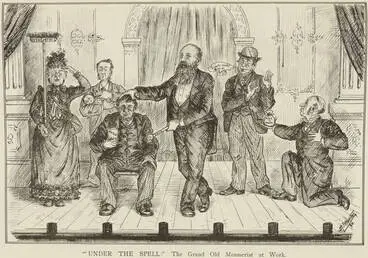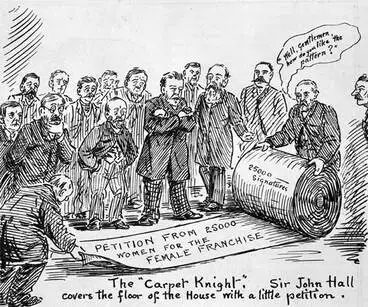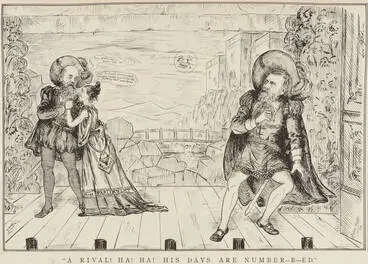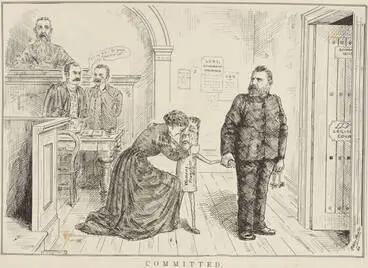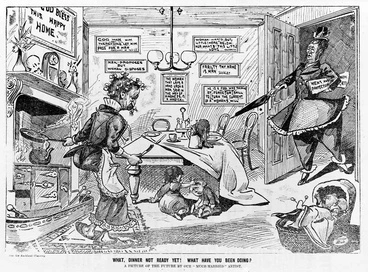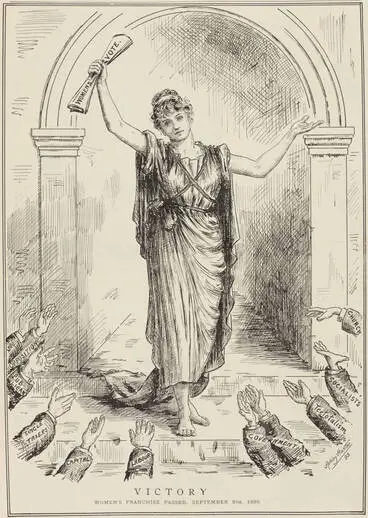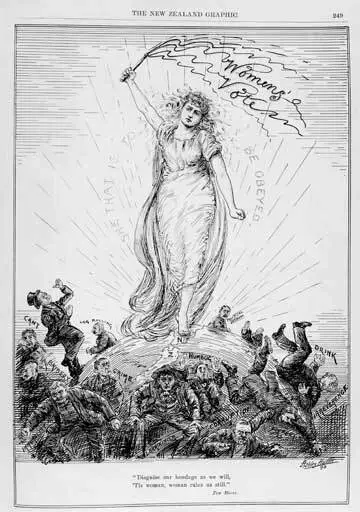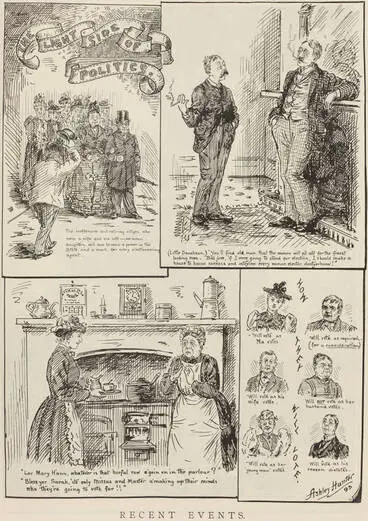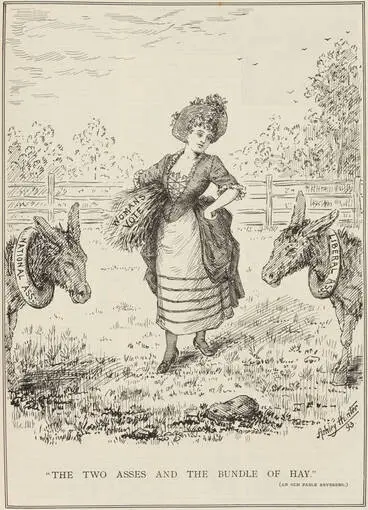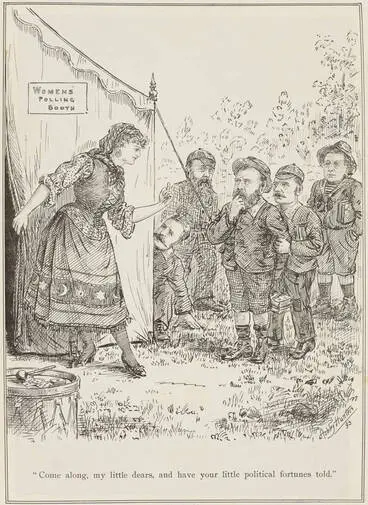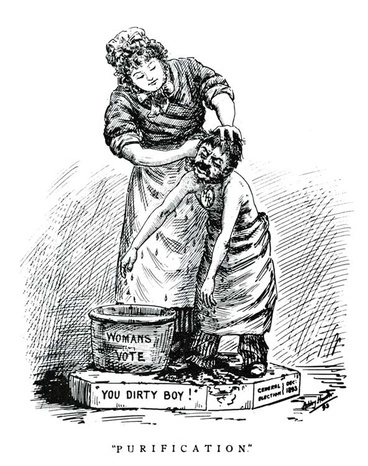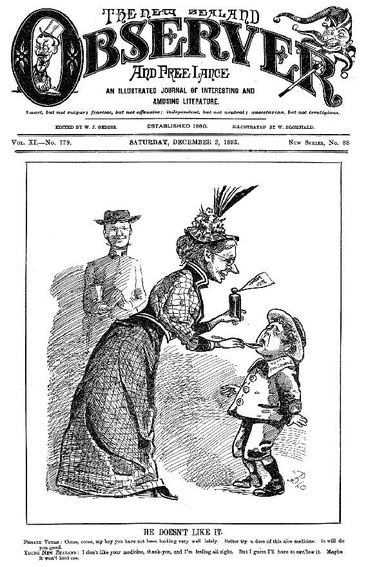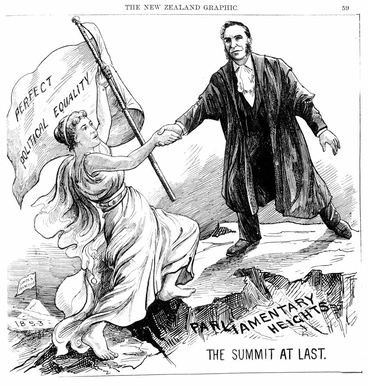Sign a Petition
A DigitalNZ Story by Auckland Libraries Heritage Collections
Small acts can be powerful! In 1893 an estimated 31,872 women took action by signing the suffrage petition. This story shows how the 1893 suffrage bill was represented in satirical newspaper cartoons of the day. #suffrage125 #wahinetakeaction
Suffrage, Women, Nineteenth century, cartoons, satire, feminism
Recent Events: Scenes in the House and home. 28 May 1887.
Politics and Parliament is not a natural environment for a decent, domesticated woman!
National Library of New Zealand
Is there a mote in your eye? 5 September 1891.
Mr Buick thinks female suffrage will bring about social and political purity. So mote it be!
National Library of New Zealand
"Under the spell:" The Grand Old Mesmerist at work. 28 July 1893.
Sir Robert Stout charmed employers to pay workers higher wages, drunks to drink water and has granted women votes.
Auckland Libraries
The Carpet Knight. 12 August 1893.
Sir John Hall (women's suffrage supporter) is carpeting the floor of the Lower House with the suffrage petition.
Manatū Taonga, the Ministry for Culture and Heritage
"A Rival, Ha Ha! His days are numbered." 12 August 1893.
Rivalry between Sir Robert Stout (left - wooing women voters) and Richard Seddon (now scheming to steal their support.)
Auckland Libraries
How the Women got the Vote
The movement for women's suffrage in New Zealand was closely identified with the Women's Christian Temperance Movement (WCTU.) The WCTU campaigned against the disastrous effects of uncontrolled liquor on society. They showed how devastating liquor could be as male drunkards destroyed the lives of their wives and families. Many men could sympathise with the Temperance Unionists and this led to many politicians from the House of Representatives being favourably disposed to the cause of women's suffrage. Sir John Hall introduced women's franchise bills in 1890 and 1891 and these were passed by the House of Representatives but were defeated by the Legislative Council. Then in 1891, 1892 and 1893 three massive petitions were presented to Parliament by the women of New Zealand requesting the right of universal female suffrage. By this time women's demands for suffrage was supported by a degree of male goodwill and there was no real substantial, co-ordinated and sustained backlash throughout the country. It was clear that the people of New Zealand now expected their politicians to implement political change. Let's look at the issue of women's suffrage through the eyes of two politicians from opposing sides of Parliament, and then see how universal women's suffrage was introduced in New Zealand.
Committed. 26 August 1893.
Women's votes 'Bill' is sent for trial by a reluctant Liberal Government. Sir John Hall is judge and Seddon the jailer.
Auckland Libraries
Fie, for shame, Georgie! 2 September 1893.
Don't sit on our Bill, you nasty man! Amy Daldy and friend accost George B. Morris who thinks Bill was made to sit on!
National Library of New Zealand
Petticoat era - we have reached it at last. 16 September 1893.
Ms Politician arrives home and finds hubby hasn't cooked dinner and can't control the kids - what's he done all day?
Manatū Taonga, the Ministry for Culture and Heritage
Victory, women's franchise passed. 16 September 1893.
A triumphant woman celebrates the passage of Women's Franchise, Now all political parties are seeking the women's vote.
Auckland Libraries
Smiles and frowns: women's franchise at work. 16 September 1893.
Women give bouquets to politicians who voted for women's suffrage and brickbats to those who voted against.
National Library of New Zealand
Lovely woman triumphs at last! 23 September 1893.
Showing the trials and tribulations of the modern emancipated woman.
National Library of New Zealand
Sir John Hall
Sir John Hall was a conservative Canterbury politician with a reputation for political integrity. He was a polite and courteous gentleman who was prepared to listen seriously to women and to treat them with respect. His style was most acceptable to the suffragists and Kate Sheppard, who led the WCTU's political department, appealed to him to support and advocate for women's suffrage in Parliament. Hall responded to her appeal with alacrity. For six years between 1887 and 1893 he attempted time and time again to have the women's suffrage issue debated in the House of Representatives. In 1890 he introduced a Women's Franchise Bill, and in 1891 a Female Suffrage Bill. Both were passed by the House of Representatives but were defeated by the Legislative Council. However Hall still persevered and maintained close consultation with Kate Sheppard to keep the suffrage movement outside Parliament informed of progress.
Hall thought that women could be an intelligent and conservative moral force in politics. He hoped they would use their votes to moderate the more extreme activities and behaviour in Parliament. He believed that giving women the vote would 'increase the influence of the settler or family man, as against the loafing single-men who had so great a voice at the last elections.' He had already noted with concern the increasing influence of 'the larrikin pothouse element' in New Zealand politics since the Liberal victory in the 1890 election. In other words, Hall hoped women's votes would moderate some of the wilder policies and programmes of radical Liberal politicians like Seddon, McKenzie and Reeves, and also the influence of their Labour and unionist allies.
Disguise our bondage as we will, tis woman, woman, rules us still. 30 September 1893.
It is only the good judgement and moral influence of women voters that will control vices in male-dominated society.
Manatū Taonga, the Ministry for Culture and Heritage
Recent Events. How will they vote? 14 October 1893.
Montage of political cartoons about the impact of women's votes on elections and political parties.
Auckland Libraries
The Two Asses and the Bundle of Hay. 21 October 1893.
A young woman decides which ass to vote for - she represents women voters who have no real choice between the 2 parties.
Auckland Libraries
"Come along, my little dears, and have your little political fortunes told." 21 October 1893.
Women voters can now determine the Liberals' fortunes. From left JG Ward, J McKenzie, R Seddon, WP Reeves and A Cadman.
Auckland Libraries
The rush of the first seven. 28 October 1893.
The first seven women to sign the suffrage petition rush to be included in the commemorative photographic shield.
National Library of New Zealand
The rush to be taken. Everyone wants to stand in front. 28 October 1893.
All women are equal but some women are more equal than others.
National Library of New Zealand
Richard Seddon
Richard Seddon was a member of the Liberal Party. His party's position required him to publicly endorse women's suffrage. However, personally Seddon did not support either temperance or women's suffrage. As an ex-publican he was well-aware of that anti-liquor policies would not attract votes for the Liberals and would also jeopardise the party's financial support from brewing interests. Likewise as a man, Seddon regarded himself as one of the 'lords of creation.' He no doubt saw women's role as childbearers, cooks and churchgoers - but not as voters at the ballot box.
However as a Liberal, he had to go through the motions and pay lip-service to women's suffrage. So after Sir John Hall proposed another women's franchise amendment to the Governments' 1893 Electoral Bill, Seddon allowed it through the House, assuming the Legislative Council would reject it. In an attempt to guarantee this, he obtained the consent of new Liberal Legislative Councillor Thomas Kelly to alter his paired vote so that he would instead vote against the bill. However, two Opposition councillors were so incensed at Seddon's high-handed manipulation that they switched sides and voted for it and the bill passed by 20 votes to 18. Universal women's suffrage was signed into New Zealand law on 19 September 1893. Now all Maori and Pakeha women had the right to vote.
That 'shield': the first seven lady franchisists have their portraits taken for the Queen. 28 October 1893.
Queen Victoria and Prince Edward inspect the ladies' fashion, and a national memorial statue is planned for New Zealand.
National Library of New Zealand
"Clearing the path for himself," or Sir Robert Stout's political policy. 11 November 1893.
Sir Robert Stout is using temperance supporters and women voters to clear his path His street sweeper is a mini Stout.
Auckland Libraries
Purification - you dirty boy! 18 November 1893.
Cartoon suggesting women will use their votes to clean up Parliament.
Manatū Taonga, the Ministry for Culture and Heritage
He Doesn't Like It! 2 December 1893.
Women are dispensing unnecesssary 'moral' medicine to male voters who don't want it but know they'll have to swallow it.
Manatū Taonga, the Ministry for Culture and Heritage
The big franchise woman and the little mouse. 17 February 1894.
Well, Mary Jane, you've got your vote and your women's rights - but you're still afraid of a little mouse!
National Library of New Zealand
The Summit At Last! 21 July 1894.
A woman holding a flag proclaiming Perfect Political Equality is helped up Parliamentary Heights by a man in legal robes
Manatū Taonga, the Ministry for Culture and Heritage
Further Reading
Grimshaw, Patricia, 'Women Campaign for the Vote,' New Zealand's Heritage: the making of a nation, v.10, Sydney, 1971, pp. 1295-1300.
King, Michael, The Penguin History of New Zealand, Auckland, 2003.
Oliver, W.H., ed, The Oxford History of New Zealand, Wellington, 1981.
'New Zealand women and the vote', URL: https://nzhistory.govt.nz/politics/womens-suffrage, (Ministry for Culture and Heritage), updated 13 Mar-2018.
Adding insult to injury. 18 December 1911.
Does your wife insist on being allowed to vote? Sawbones tells his doctor she does, and how he is afflicted by this.
National Library of New Zealand
